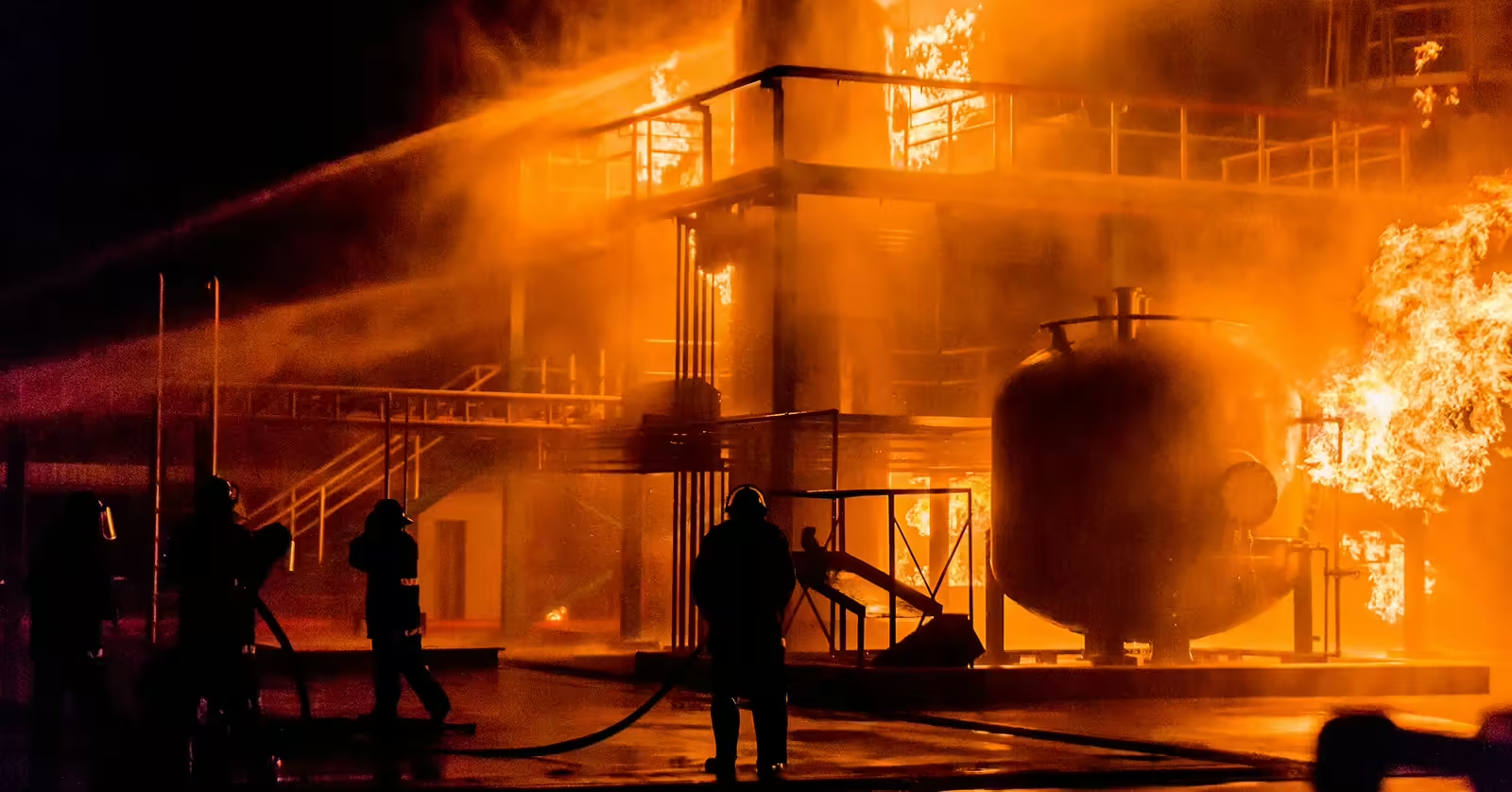Everything You Need to Know About Burn Injury Lawsuits
December 29, 2023

Industrial fires are dangerous accidents that can result in serious burn injuries and deaths to the workers and first responders at the site of the fire, but can also injure community members near the site of the fire. Most industrial fires are preventable with standard safety measures and policies.
An experienced burn injury attorney can help you and your family navigate the legal process, prove negligence and damages, and help you recover the full monetary damages you’re owed.
How Many Industrial Fire Injuries Happen Each Year?
According to the National Fire Protection Association, there is an estimated 37,000 industrial fires each year in the United States alone.
Definition: Industrial Fires: Industrial fires are a district form of fire that occurs in industrial settings, such as a factory, processing plant, mill, warehouse, or other industrial structure.
Industrial fires are significantly more dangerous than residential fires because the industrial setting of the fire often involves reactive chemicals or other highly flammable materials that fuel the fire and create more intense flames, toxic smoke, and explosions. For example, industrial gasoline processing or storage facilities often contain extremely flammable and explosive liquids that are not found in people’s homes. Thus, these fires are more dangerous for the employees near the fire and are harder for first responders to extinguish.
Those caught in the path of the fire or the resulting explosion can experience significant burn injuries or even death. The most common injuries from industrial fires are burn injuries, smoke inhalation injuries, explosion injuries, chemical exposure injuries, fall and trampling injuries, heat exhaustion, hearing loss, and psychological injuries, such as post-traumatic stress disorder. Those who survive the fire are often left with permanent lifelong conditions such as disfigurement from their burns and permanently reduced respiratory function from the inhalation of toxic smoke.
The community surrounding the fire and explosion can also be significantly injured.
For example, the Intercontinental Terminals Company, LLC (ITC) storage tank fire in Deer Park, Texas, involved a fire of fifteen 80,000-barrel aboveground storage tanks containing various chemicals involved in the production of gasoline, such as naphtha, toluene, and butane. The fire lasted over 3 days and caused various toxic chemicals, such as benzene and particulate matter, to pollute the local communities’ breathable air. The air monitoring levels of these chemicals were so elevated that a shelter-in-place order was issued for the entire city of Deer Park, closing schools and shutting down highways. Many of the residents reported acute inhalation injuries due to their exposure to these pollutants, such as bloody noses, burning eyes, wheezing, coughing, asthma attacks, heart palpitations, shortness of breath, and reactive airway disease. Thus, even communities near industrial sites are at risk of injuries from these preventable fires.
Common Causes Of Industrial Fire Accidents
Many of the common preventable causes of industrial and manufacturing fires result from the general negligence of the company in control of the site and the operations at the site. As is often the case, many companies responsible for these fires chose profits over safer operations. Some examples of these preventable causes of these fires and explosions are;
- Failure to Adequately Train Employees
- Lack of Safety and Training Procedures
- Inadequate or Infrequently Performed Maintenance
- Process Safety Management Failures
Inadequate or Infrequently Performed Maintenance
Inadequate or infrequent preventive maintenance is one of the primary root causes of industrial fires. Companies routinely avoid costly preventative maintenance to deliver better short-term financial results. However, this lack of preventative maintenance can lead to an increased chance that equipment used in the industrial process will fail and start a fire or explosion.
For example, the lack of preventative maintenance of a circulation pump was determined to be one of the root causes of the ITC industrial storage tank farm fire.
The ITC storage tank farm fire originally started from the failure and overheating of a circulation pump next to a storage tank. ITC’s operations included increasing the octane levels of gasoline to produce jet fuel. To do this, ITC would bring in trucks filled with extremely flammable and toxic additives that would connect to the circulation pump to mix the gasoline with the additives.
Approximately three months before the fire, ITC personnel reported to the maintenance department that this circulation pump was making loud noises while in use. ITC maintenance personnel rebuilt the circulation pump at the maintenance shop using some spare parts and reinstalled it on the existing pump skid.
ITC did not have a formal preventative maintenance program in place for the circulation pump that included routine maintenance and inspection activities recommended by the pump manufacturer, nor did they have a written pump rebuild or replacement procedure in place that referenced the pump manufacturer’s recommended instructions to ensure a proper installation of the circulation pump when it was rebuilt.
Moreover, ITC did not provide maintenance personnel with formal, documented training related to pump maintenance and repair work and did not have a formal program in place to assess their competency and ITC did not have a quality assurance program in place at the ITC Deer Park terminal to allow it to confirm the origin of replacement parts used in the rebuild of the failed circulation pump.
All of these failures were entirely preventable. ITC chose not to implement these as a way to save on expenses. After the fire was put out and the damage was done, investigators determined that the bearings and seals on the circulation pump failed during this mixing process, which caused the pump to overheat and eventually catch on fire.
This first failure led to the fire of only one tank farm’s tanks. Additional failures led to the fire spreading to additional tanks and increasing the fire’s intensity. One of these additional failures was ITC’s cost-cutting approach to effective fire safety, prevention, and containment processes.
Failure to Mitigate Known Hazards
Industrial fires often result from companies failing to reduce the risk of fires from known potential causes, commonly known hazards. For example, companies that produce grain, food and pharmaceuticals, metals, wood, coal, and polymers/plastics often have combustible dust as a byproduct of their operations, and these companies know that there need to be safety processes in place to reduce the risk of a fire or explosion occurring.
Companies should implement passive and active engineering controls to mitigate the risk of fire and explosions from combustible dust or other known hazards. Passive controls reduce hazards through design without activation, while active controls detect and activate a system in response.
The failure to properly mitigate and control the risk of known hazards can lead to devastating fires and explosions. For example, ITC could have implemented tank farm design changes, such as increased tank spacing and subdivisions, which could have prevented the spreading and escalation of the fire to the additional tanks. Additionally, ITC could have implemented active engineering controls such as remotely operated emergency isolation valves to prevent the continuous fueling of the fire.
The issue with failing to have remotely operated emergency isolation valves is that a small fire can escalate into a major fire because personnel cannot reach and close manual block valves safely or quickly enough, leading to an unconstrained fuel supply to the fire. This is exactly what happened at the ITC facility.
ITC did not have a remotely operated emergency isolation valve on the tank that caught fire. Thus, the large volume of flammable and toxic liquid in the storage tank could not be remotely or automatically isolated. The only way to stop fuel flow to the fire was to manually turn off the valve by hand. However, since the flames immediately engulfed the entire area, neither ITC personnel nor emergency responders could physically access the supply and return valves on the tank to manually close them and isolate the tank. As a result, the butane-enriched naphtha product continued to release from the tank via the failed pump and fueled the fire that continued to intensify.
Types of Compensable Damages in Burn Injury Lawsuits
Individuals injured or killed by an industrial fire or explosion are often entitled to compensation if the fire could have been prevented by proper preventative maintenance, mitigation of known hazards, or other neglected responsibilities by companies. These companies have a legal duty and obligation to their employees and community to maintain a safe environment and to minimize the risk of fires and explosions. Companies that fail in these duties can be held liable for the resulting injuries.
Compensation for those injured from these fires can include compensation for pain, suffering, and mental anguish, payment of medical bills, lost wages due to injuries, and even compensation for loss of consortium.
How Much Are Burn Injury Cases Worth In Texas?
Many verdicts and settlements involving industrial fires and explosions are worth millions of dollars.
One jury in Houston, Texas, awarded 20 million dollars to the family of one man who was killed and two men who were severely injured by a natural gas pipeline explosion. The men were not warned of the risk of fire and explosion, and the pipes were never properly vented or purged before the demolition project began.
Another jury in Houston, Texas, awarded 30 million dollars to five victims of an ExxonMobil explosion and fire where ExxonMobil knew that the cause of the fire and explosion existed for years and chose to do nothing about it.
However, not every case has to go to trial. Our burn injury attorneys were able to secure a multi-million dollar settlement for the employees, first responders, and community members who were injured as a result of the ITC deer park fire.
How much do Burn Injury Lawyers Cost?
Many people injured by industrial fires worry about how much they will have to pay to hire a burn injury attorney to represent and fight for them. Here at Morrow & Sheppard LLP, our attorneys require no upfront payment and payment is entirely based on the outcome of your case. This agreement is commonly referred to as a contingency fee agreement, and the law firm’s payment is contingent upon winning the case or securing a settlement for you. You do not pay attorney fees if the law firm does not win the case or achieve a settlement. The lawyer’s fee is typically a predetermined percentage of the total amount recovered through the lawsuit or settlement. This percentage varies but is often around 33% to 40%, depending on if a lawsuit is filed on your behalf.
Why Choose Our Burn Injury Law Firm?
If you or a loved one has been injured from an industrial fire or explosion, you need a top-tier Texas Burn Injury Attorney who has handled cases across the state in Houston, Austin, Brownsville, Abeline, Amarillo, and other cities. Here at Morrow & Sheppard, our burn injury attorneys will fight these large corporations to obtain the largest compensation you are entitled to. Our attorneys have been heavily involved in obtaining multiple millions of dollars from careless companies like ITC.
Michael Null is a determined trial attorney who is passionate about achieving the best results for his clients. Mr. Null is admitted to practice law in Texas and Colorado. He represents injured persons in the areas of oilfield injuries, maritime accidents, railroad accidents, medical malpractice, products liability, premises liability, car and trucking accidents, mass torts, and related personal injury claims. You can learn more about Michael.
- Home
- |
- Plant, Refinery & Industrial Accidents
- |
- Everything You Need to Know...
















































